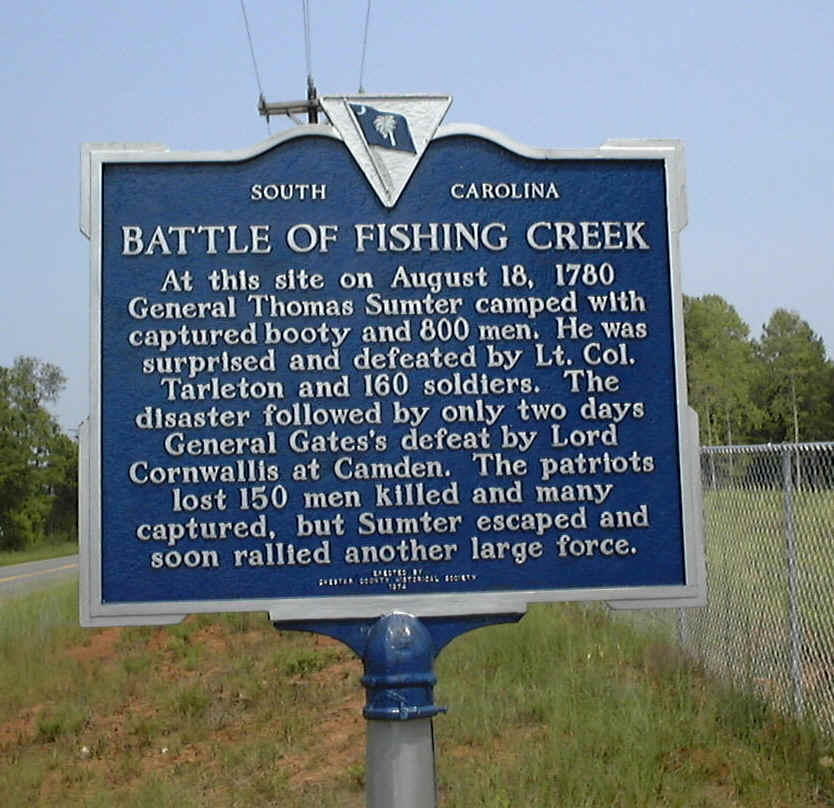 SIR BANASTRE TARLETON (1754-1833), English soldier, was the son of John Tarleton (1719-1773), a Liverpool merchant, and was born in Liverpool on the 21st of August 1754. Educated at Oxford he entered the army, and in December
SIR BANASTRE TARLETON (1754-1833), English soldier, was the son of John Tarleton (1719-1773), a Liverpool merchant, and was born in Liverpool on the 21st of August 1754. Educated at Oxford he entered the army, and in December engagement with Thomas Sumter at Fishing Creek, or Catawba Fords,
engagement with Thomas Sumter at Fishing Creek, or Catawba Fords, but was not equally successful when he encountered the same general at Blackstock Hill in November 1780; then in January 1781, in spite of much personal valour, he was defeated with heavy loss at Cowpens. Having been successful in a skirmish at Tarrants House, and having taken part in the battle of Guilford in March 1781, he marched with Cornwallis into Virginia, and after affording much assistance to his commander-in-chief he was instructed to hold Gloucester. This post, however, was surrendered to the Americans with Yorktown in October 1781, and Tarleton returned to England on parole. In 1790 he entered parliament as member for Liverpool, and with the exception of a single year he remained in the House of Commons until 1812. In 1794 he became a major-general; in 1812 a general; and he held a military command in Ireland and another in England. In 1815 he was made a baronet. He died without issue at Leintwardine in Shropshire on the 25th of January 1833.
but was not equally successful when he encountered the same general at Blackstock Hill in November 1780; then in January 1781, in spite of much personal valour, he was defeated with heavy loss at Cowpens. Having been successful in a skirmish at Tarrants House, and having taken part in the battle of Guilford in March 1781, he marched with Cornwallis into Virginia, and after affording much assistance to his commander-in-chief he was instructed to hold Gloucester. This post, however, was surrendered to the Americans with Yorktown in October 1781, and Tarleton returned to England on parole. In 1790 he entered parliament as member for Liverpool, and with the exception of a single year he remained in the House of Commons until 1812. In 1794 he became a major-general; in 1812 a general; and he held a military command in Ireland and another in England. In 1815 he was made a baronet. He died without issue at Leintwardine in Shropshire on the 25th of January 1833. For some time Tarleton lived with the actress Mary Robinson (Perdita),
 and his portrait was painted both by Reynolds and by Gainsborough. Sir Banastre wrote a History of the Campaigns of 1780 and 1781 in the Southern Provinces of North America (London, 1781)
and his portrait was painted both by Reynolds and by Gainsborough. Sir Banastre wrote a History of the Campaigns of 1780 and 1781 in the Southern Provinces of North America (London, 1781) , which, although of some value, is marred by the author's vanity and by his attacks on Cornwallis. It was criticized by Colonel Roderick Mackenzie in his Strictures on Lieutenant-Colonel Tarleton's History (1781) 'and in the Cornwallis Correspondence.
, which, although of some value, is marred by the author's vanity and by his attacks on Cornwallis. It was criticized by Colonel Roderick Mackenzie in his Strictures on Lieutenant-Colonel Tarleton's History (1781) 'and in the Cornwallis Correspondence.
No comments:
Post a Comment